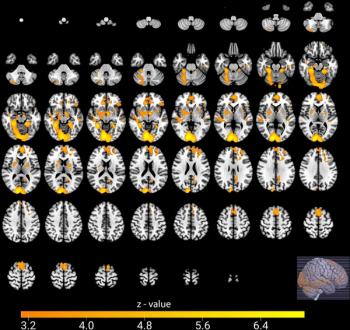
Long Time in Space Leads to Pressure on the Brain
Astronauts experience a sustained increase in brain volume and other impacts.
Going into space conjures images of weightlessness, floating around without any impact on your body. But, in reality, it’s long been known that extended stints in outer space can atrophy muscles and damage eyesight. And, now, it also turns out that astronauts who spend significant time in orbit also develop an increase in brain volume.
In a study published Tuesday in
“When you’re in microgravity, fluid, such as your venous blood no longer pools toward your lower extremities, but redistributes headward,” Kramer said. “That movement of fluid toward your head may be one of the mechanisms causing changes we are observing in the eye and intracranial compartment.”
The increased pressure is likely responsible for swelling of the optic nerve and retinal hemorrhage, he said. But, it also causes more changes in the body, he said.
To determine the impacts of space flight, Kramer’s team performed MRI exams on the astronauts prior to their flight to the International Space Station, as well as an exam the day after their return. They also conducted several follow-up exams throughout the subsequent year.
According to image analysis, the researchers determined that long-term exposure to microgravity expands both the brain and the cerebrospinal fluid. The most significant increase was in the brain’s white matter. These levels stay elevated for at least a year post-flight, suggesting that these are permanent changes, he said.
The intracranial pressure created more changes than increased brain volume, however. Imaging also revealed deformations to the pituitary gland, the pea-sized gland at the base of the brain that controls the function of other glands in the body.
“We found that the pituitary gland loses height and is smaller post-flight than it was pre-flight,” Kramer said. “In addition, the dome of the pituitary gland is predominantly convex in astronauts without prior exposure to microgravity but showed evidence of flattening or concavity post-flight. This type of deformation is consistent with exposure to elevated intracranial pressures.”
In addition, investigators identified an increased velocity in the cerebrospinal fluid through the channel that connects the ventricles in the brain. This uptick is similar to what is seen with normal pressure hydrocephalus, a condition in which the brain’s ventricles are abnormally enlarged. Patients with this condition usually experience difficulty walking, bladder control problems, and dementia. However, Kramer said, these problems haven’t been reported in astronauts post-flight.
The team is using these findings to study ways to counteract the microgravity effect, such as using negative pressure on the lower extremities to control the shift of fluid toward the head. The hope, Kramer said, is that these findings will provide a clinical benefit for non-astronaut patients.
“If we can better understand the mechanisms that cause ventricles to enlarge in astronauts and develop suitable countermeasures, then, maybe some of these discoveries could benefit patients with normal hydrocephalus and other related conditions,” he said.
Newsletter
Stay at the forefront of radiology with the Diagnostic Imaging newsletter, delivering the latest news, clinical insights, and imaging advancements for today’s radiologists.



























